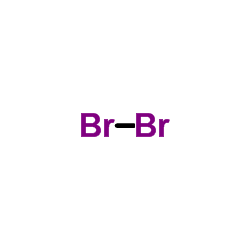13777-25-8
| 中文名 | 溴化锆(IV) |
|---|---|
| 英文名 | Zirconium(IV) bromide |
| 中文别名 | 溴化锆 |
| 英文别名 |
tetrabromozirconium
EINECS 237-417-4 MFCD00049637 |
| 密度 | 4,201 g/cm3 |
|---|---|
| 熔点 | 450°C |
| 分子式 | Br4Zr |
| 分子量 | 410.84000 |
| 精确质量 | 405.57800 |
| LogP | 3.38240 |
| 外观性状 | 粉末 |
| 蒸汽压 | 20200mmHg at 25°C |
| 储存条件 | 常温密闭,阴凉通风干燥惰性气体下 |
| 稳定性 | 常温常压下稳定 避免的物料 水分/潮湿 酸.有吸湿性,遇水分解。 |
| 分子结构 | 1、摩尔折射率:无可用的 2、摩尔体积(cm3/mol):无可用的 3、等张比容(90.2K):无可用的 4、表面张力(dyne/cm):无可用的 5、介电常数:无可用的 6、极化率(10-24cm3):无可用的 7、单一同位素质量:405.578022 Da 8、标称质量:406 Da 9、平均质量:410.84 Da |
| 计算化学 | 1.疏水参数计算参考值(XlogP):无 2.氢键供体数量:0 3.氢键受体数量:0 4.可旋转化学键数量:0 5.互变异构体数量:无 6.拓扑分子极性表面积0 7.重原子数量:5 8.表面电荷:0 9.复杂度:19.1 10.同位素原子数量:0 11.确定原子立构中心数量:0 12.不确定原子立构中心数量:0 13.确定化学键立构中心数量:0 14.不确定化学键立构中心数量:0 15.共价键单元数量:1 |
| 更多 | 1. 性状:无色结晶。 2. 密度(g/mL,25/4℃):4.201 3. 相对蒸汽密度(g/mL,空气=1):未确定 4. 熔点(ºC):450(15atm) 5. 沸点(ºC,常压):未确定 6. 沸点(ºC,5.2kPa):未确定 7. 折射率:未确定 8. 闪点(ºC):未确定 9. 比旋光度(º):未确定 10. 自燃点或引燃温度(ºC):不适用的 11. 蒸气压(kPa,25ºC):未确定 12. 饱和蒸气压(kPa,60ºC):未确定 13. 燃烧热(KJ/mol):未确定 14. 临界温度(ºC):未确定 15. 临界压力(KPa):未确定 16. 油水(辛醇/水)分配系数的对数值:未确定 17. 爆炸上限(%,V/V):未确定 18. 爆炸下限(%,V/V):未确定 19. 溶解性:分解 20. 升华点为:357℃ |
|
Section 1: Product Identification Chemical Name:Zirconium (IV) bromide, 98% (99+%-Zr) CAS Registry Number:13777-25-8 Formula:ZrBr4 EINECS Number:237-417-4 Chemical Family:metal halide Synonym:Zirconium tetrabromide
Section 2: Composition and Information on Ingredients IngredientCAS NumberPercentACGIH (TWA)OSHA (PEL) Title Compound13777-25-8100%5mg/m3 (as Zr)5mg/m3 (as Zr) Section 3: Hazards Identification With moisture, this material becomes a strong, corrosive acid. The liquid and its vapor are extremely corrosive Emergency Overview: to skin, eyes, mucous membranes and respiratory tract. Primary Routes of Exposure:Ingestion, inhalation, eyes and skin Eye Contact:Severe corrosive to the eyes. Exposure can lead to permanent eye damage. Skin Contact:Corrosive to skin. Contact can lead to redness, pain, blistering, ulceration, and scar formation. Material releases corrosive fumes. Severe burning of the mucous membranes and lungs. Pulmonary edema Inhalation: may occur. Product is a highly corrosive acid. Ingestion may cause pain, vomiting, burns of mouth and throat, and Ingestion: ulceration of gastrointestinal tract. Acute Health Affects:Severe corrosive to eyes, skin, mucous membranes and respiratory tract. Ingestion may be fatal. Repeated or prolonged exposure to bromides by any route may cause skin rashes (bromaderma) and central Chronic Health Affects: nervous system depression, including ataxia, psychoses, memory loss, irritability, and headache. NTP:No IARC:No OSHA:No SECTION 4: First Aid Measures Immediately flush the eyes with copious amounts of water for at least 10-15 minutes. A victim may need Eye Exposure: assistance in keeping their eye lids open. Get immediate medical attention. Wash the affected area with water. Remove contaminated clothes if necessary. Seek medical assistance if Skin Exposure: irritation persists. Remove the victim to fresh air. Closely monitor the victim for signs of respiratory problems, such as difficulty Inhalation: in breathing, coughing, wheezing, or pain. In such cases seek immediate medical assistance. Seek medical attention immediately. Keep the victim calm. Give the victim water (only if conscious). Induce Ingestion: vomiting only if directed by medical personnel. SECTION 5: Fire Fighting Measures Flash Point:not applicable Autoignition Temperature:none Explosion Limits:none Extinguishing Medium:None. Material is non-flammable. If this product is involved in a fire, fire fighters should be equipped with a NIOSH approved positive pressure Special Fire Fighting Procedures: self-contained breathing apparatus and full protective clothing. Hazardous Combustion andnone Decomposion Products: Unusual Fire or Explosion Hazards: No unusual fire or explosion hazards. SECTION 6: Accidental Release Measures Small spills can be mixed with powdered sodium bicarbonate, lime, or calcium carbonate and swept up. Avoid Spill and Leak Procedures: raising dust. SECTION 7: Handling and Storage Store solid in a tightly sealed container away from moisture. Handle in a fume hood under a dry atmosphere of Handling and Storage: air or nitrogen. Prolonged exposure to the atmosphere may degrade the product. SECTION 8: Exposure Controls and Personal Protection Eye Protection:Always wear approved safety glasses when handling a chemical substance in the laboratory. Skin Protection:Wear protective clothing and gloves. Consult with glove manufacturer to determine the proper type of glove. Ventilation:The solid may form corrosive vapors. It should be handled in an efficient fume hood. If in form of fine dust and ventilation is not available a respirator should be worn. The use of respirators Respirator: requires a Respirator Protection Program to be in compliance with 29 CFR 1910.134. Ventilation:The solid may form corrosive vapors. It should be handled in an efficient fume hood. Additional Protection:No additional protection required. SECTION 9: Physical and Chemical Properties Color and Form:off-white pwdr. Molecular Weight:410.86 Melting Point:450° (15 atm) Boiling Point:no data Vapor Pressure:no data Specific Gravity:4.201 Odor:pungent odor Solubility in Water:reacts with water SECTION 10: Stability and Reactivity Stability:moisture sensitive Hazardous Polymerization:no hazardous polymerization Conditions to Avoid:contact with moisture Incompatibility:water, mineral acids and active metals Decomposition Products:none SECTION 11: Toxicological Information RTECS Data:No information available in the RTECS files. Carcinogenic Effects:no data Mutagenic Effects:no data Tetratogenic Effects:no data SECTION 12: Ecological Information Ecological Information:No information available SECTION 13: Disposal Considerations Disposal:Dispose of according to local, state and federal regulations. SECTION 14: Transportation Shipping Name (CFR):Corrosive solids, N.O.S. Hazard Class (CFR):8 Additional Hazard Class (CFR):NA Packaging Group (CFR):I UN ID Number (CFR):UN# 1759 Shipping Name (IATA):Corrosive solid, N.O.S. Hazard Class (IATA):8 Additional Hazard Class (IATA):NA Packaging Group (IATA):I UN ID Number (IATA):UN# 1759 SECTION 15: Regulatory Information TSCA:Listed in the TSCA inventory. SARA (Title 313):Title compound not listed. Second Ingredient:none SECTION 16 - ADDITIONAL INFORMATION N/A |
|
毒理学数据: 1、急性毒性:主要的刺激性影响: 在皮肤上面:在皮肤和粘膜上造成腐蚀性影响,刺激皮肤和粘膜; 在眼睛上面:强烈的腐蚀性影响,刺激的影响;没有已知的敏化影响。 生态学数据: 通常对水体是稍微有害的,不要将未稀释或大量产品接触地下水,水道或污水系统,未经政府许可勿将材料排入周围环境。
|
| 符号 |

GHS05 |
|---|---|
| 信号词 | Danger |
| 危害声明 | H314 |
| 补充危害声明 | Reacts violently with water. |
| 警示性声明 | P280-P305 + P351 + P338-P310 |
| 危害码 (欧洲) | C: Corrosive; |
| 风险声明 (欧洲) | R20/21/22 |
| 安全声明 (欧洲) | S22-S26-S27-S36/37/39-S45 |
| 危险品运输编码 | UN 3260 8/PG 2 |
| WGK德国 | 3 |
| 包装等级 | III |
| 危险类别 | 8 |
|
~% 
13777-25-8 |
| 文献:Z. Ch. (2), , vol. 6, p. 296 - 297 |
|
~% 
13777-25-8 |
| 文献:Zr: MVol., 55, page 165 - 167 The properties of zirconium, NP-266 (1947) 12 |
|
~32% 
13777-25-8 |
| 文献:Calderazzo, Fausto; Pallavicini, Piersandro; Pampaloni, Guido Journal of the Chemical Society, Dalton Transactions: Inorganic Chemistry (1972-1999), 1990 , # 6 p. 1813 - 1818 |
| 上游产品 3 | |
|---|---|
| 下游产品 2 | |






